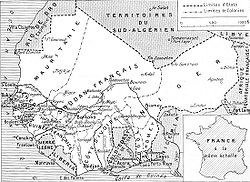Colonial Mauritania
| Colony of Mauritania | ||||||||||
| Colonie de la Mauritanie | ||||||||||
| Constituent of French West Africa | ||||||||||
|
||||||||||
|
Anthem La Marseillaise • National anthem of Mauritania (instrumental only) |
||||||||||
|
Map of the seven colonies of French West Africa in 1936. Note that the eighth colony, French Upper Volta was in this period parceled between its neighbors. French Sudan also contains a large portion of what is today the eastern half of Mauritania.
|
||||||||||
| Capital |
Saint-Louis (exterritorial) (1903–1957) Nouakchott (1957–1960) |
|||||||||
| Languages |
French Arabic |
|||||||||
| Government |
Protectorate (1903–1904) Civil territory (1904–1920) Colony (1920–1946) Overseas territory (1946–1958) Autonomous republic (1958–1960) |
|||||||||
| Commissioner | ||||||||||
| • | 1903–1905 | Xavier Coppolani | ||||||||
| • | 1916–1920 | Nicolas Jules Henri Gaden | ||||||||
| Lieutenant Governor | ||||||||||
| • | 1920–1926 | Nicolas Jules Henri Gaden | ||||||||
| • | 1956–1958 | Albert Jean Mouragues | ||||||||
| High Commissioner | ||||||||||
| • | 1958–1959 | Henri Joseph Marie Bernard | ||||||||
| • | 1959–1960 | Amédée Joseph Émile Jean Pierre Anthonioz | ||||||||
| Historical era | 20th century | |||||||||
| • | Protectorate established | May 12, 1903 | ||||||||
| • | Civil territory | October 18, 1904 | ||||||||
| • | Colony established | January 12, 1920 | ||||||||
| • | Status changed to overseas territory | October 27, 1946 | ||||||||
| • | Autonomy | November 28, 1958 | ||||||||
| • | Independence | November 28, 1960 | ||||||||
| Area | ||||||||||
| • | 1936 | 833,977 km² (322,000 sq mi) | ||||||||
| • | 1948 | 942,995 km² (364,092 sq mi) | ||||||||
| Population | ||||||||||
| • | 1936 est. | 383,000 | ||||||||
| Density | 0.5 /km² (1.2 /sq mi) | |||||||||
| • | 1948 est. | 518,000 | ||||||||
| Density | 0.5 /km² (1.4 /sq mi) | |||||||||
| Currency |
French West African franc (1903–1945) CFA franc (1945–1960) |
|||||||||
|
||||||||||
The period from the mid-nineteenth to mid-twentieth centuries is the colonial period in Mauritania.
Before the nineteenth century, the European powers in West Africa were interested only in coastal trade; they attempted no important inland exploration and established no permanent settlements (except Saint-Louis). The European mercantile companies on the coast were charged with making the highest possible profit. Four such French companies enjoyed an official French-government monopoly of the Senegal River trade from 1659 to 1798. Contact with the Maures and the black inhabitants of the valley came about only in the course of trade. From the beginning, French influence, competing with traditional trading partners north and east of Mauritania, came through Senegal.
In 1825 the new Emir of Trarza, Muhammad al Habib, sought to reassert his sovereignty over the French-protected Oualo Kingdom to the south of the Senegal River by marrying the heiress to the kingdom. This action, which French authorities viewed as a hostile threat, combined with the emir's efforts to sell gum arabic to the British, brought a strong French reaction. Although the Maures were able to lay siege to Saint-Louis, a large French expeditionary force defeated the emir's forces. The French concluded that to secure the continuing profitability of the gum arabic trade, they would have to forcibly occupy the northern bank of the Senegal River.
...
Wikipedia


